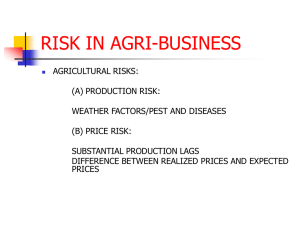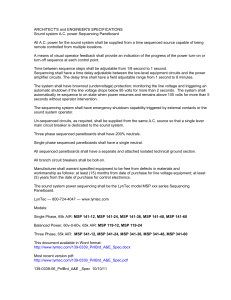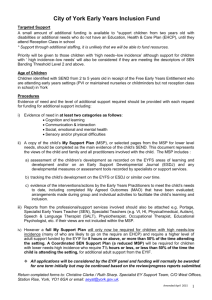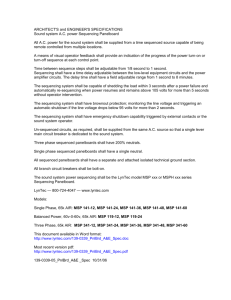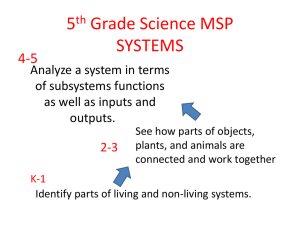a legal guide to managed services
advertisement
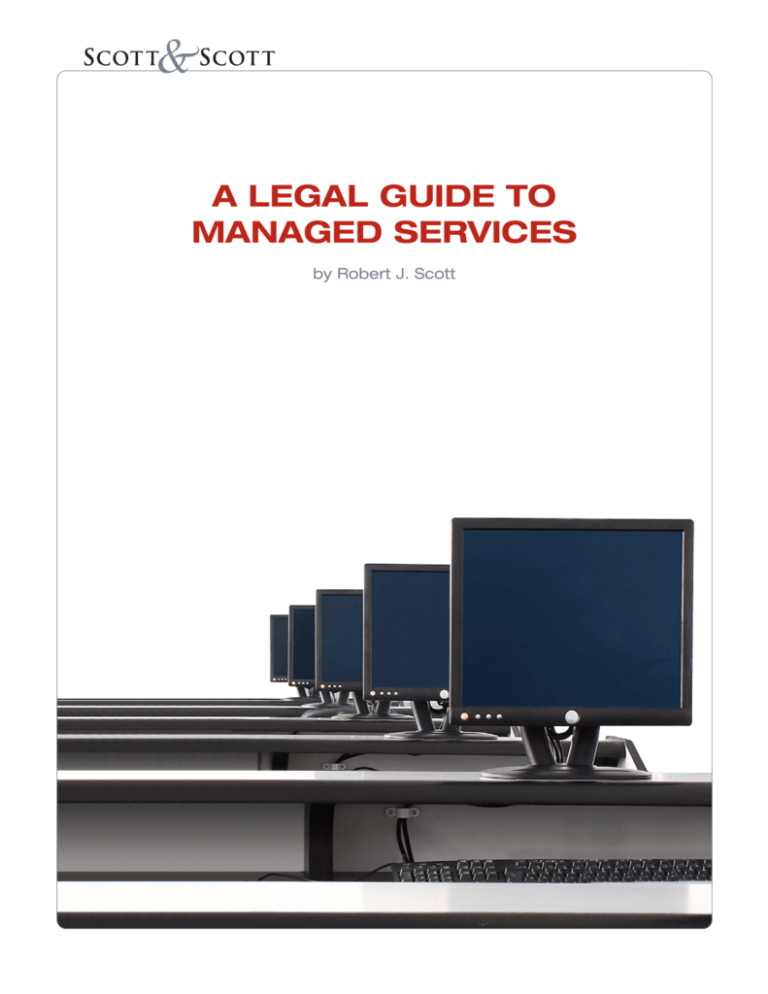
A LEGAL GUIDE TO MANAGED SERVICES by Robert J. Scott A LEGAL GUIDE TO MANAGED SERVICES Introduction A managed services provider (“MSP”) provides organizations with predictable, business-focused information technology services that optimize operations, manage risk, and deliver measurable value. Services provided by MSPs typically include remote monitoring, back-up, patch management, and help desk support. MSPs generally provide these services in exchange for a monthly service fee determined by the number of computers (servers and desktops) that the MSP is engaged to support. If you offer or are planning to offer managed services, it is important to select the right entity structure and work with experienced counsel to construct agreements with your employees, customers, and partners. This document identifies the legal issues facing MSPs from their inception, outlines strategic objectives, and provides sample contractual provisions used to achieve those objectives. Forming Your Entity and Starting Your Managed Services Business If you want to become an MSP, but do not currently have a business set up to provide those services, the first step you should take is to select the state in which you would like the business to be formed. Many companies choose the state where their principal place of business will be located. However, there may be other states with more favorable business treatment (e.g., cheaper annual franchise taxes, cheaper filing fees, or fewer procedural formation requirements) that will allow you to form your business in that state. If you choose to form your business in a state other than your own, you will need to make sure that you register the company providing MSP services as a foreign (out-of-state) business in your own state. After you choose a state, you will need to decide what you want to name your company. After you have prepared a list of possible names, you will want to check to see whether the name you want is available in the state where you want to form your business. Each state has its own set of laws regarding how to form your business, what your business can be called, and what protections will be afforded to your business. Several types of business entities, their formation requirements, and their protections are discussed below. Corporation • Can be a public company (traded on the stock market) or a private company (shareholders can purchase shares, but the stock is not traded on the stock market) • Businesses usually need to file a Certificate of Incorporation or similar document with the Secretary of State’s business or corporation division • Usually consists of shareholders and a board of director • Many states allow corporations with only one shareholder and one director, which in some instances can be the same person/entity THIS GUIDE IS FOR INFORMATIONAL PURPOSES ONLY AND SHOULD IN NO WAY BE CONSIDERED A SUBSTITUTE FOR LEGAL REPRESENTATION. PLEASE CONSULT YOUR COUNSEL TO ASSIST YOU WITH YOUR LEGAL DOCUMENTS 2200 Ross Avenue :: Suite 5350 East :: Dallas, T exas 75201 :: t 800.596.6176 :: f 800.529.3292 :: scottandscottllp.com A LEGAL GUIDE TO MANAGED SERVICES • Shareholders and directors are typically shielded from liability • May be taxed as a separate entity or as a pass-through entity. Limited Liability Company • Has no shareholders and is never traded on the stock market • Businesses usually need to file a Certificate of Formation or similar document • Usually consists of members, and in some cases, managers • Many states allow limited liability companies with only one member • Members and managers are typically shielded from liability • Can be taxed as a corporation or a partnership, at the members’ election Limited Liability Partnership • Has no shareholders and is never traded on the stock market • May need to file formation documents with the state to be entitled to protection from liability • The type of business in some states is limited to accountants, lawyers, etc. • Consists of at least two partners • Usually files a separate tax return Limited Partnership • Has no shareholders and is never traded on the stock market • May need to file formation documents with the state to be recognized as a separate entity • Consists of general and limited partners THIS GUIDE IS FOR INFORMATIONAL PURPOSES ONLY AND SHOULD IN NO WAY BE CONSIDERED A SUBSTITUTE FOR LEGAL REPRESENTATION. PLEASE CONSULT YOUR COUNSEL TO ASSIST YOU WITH YOUR LEGAL DOCUMENTS 2200 Ross Avenue :: Suite 5350 East :: Dallas, T exas 75201 :: t 800.596.6176 :: f 800.529.3292 :: scottandscottllp.com A LEGAL GUIDE TO MANAGED SERVICES • The general partner is liable for the obligations of the partnership, while the limited partner(s) liability is limited • Limited partners, in some states, may lose their limitation of liability by actively participating in the operation of the business • Usually files a separate tax return Sole Proprietorship • Is not legally distinct from its owner • Generally no formation documents are required, although a “Doing Business As” (d/b/a) Certificate can be filed with the county in which the business is operating • The owner is not shielded from liability • The owner’s personal assets may be used to satisfy any judgment entered against it • Does not usually require a separate tax return, apart from the individual’s tax return Before you begin conducting business in any state, make sure you know whether you need to register with the Secretary of the State or with the State Comptroller. Be sure to know what your sales tax obligations are, if any. You should consult with your tax professional to make sure that you comply with all accounting and financial reporting requirements. Protecting Your Intellectual Property One of the primary concerns for MSPs is protection of intellectual property. You should be aware of the various types of intellectual property and how to contractually protect each type. You should also be aware of how to avoid infringing on another company’s intellectual property, which may result in expensive and lengthy litigation. There are four primary types of intellectual property – patents, copyrights, trademarks, and trade secrets. Patents • Patents are granted by the U.S. Patent and Trademark Office (“USPTO”) for useful and novel inventions that meet stringent legal standards. Patents are property, and may be transferred to other entities. You cannot hold a patent for an invention unless it is granted by the USPTO. THIS GUIDE IS FOR INFORMATIONAL PURPOSES ONLY AND SHOULD IN NO WAY BE CONSIDERED A SUBSTITUTE FOR LEGAL REPRESENTATION. PLEASE CONSULT YOUR COUNSEL TO ASSIST YOU WITH YOUR LEGAL DOCUMENTS 2200 Ross Avenue :: Suite 5350 East :: Dallas, T exas 75201 :: t 800.596.6176 :: f 800.529.3292 :: scottandscottllp.com A LEGAL GUIDE TO MANAGED SERVICES Copyrights • Copyrights are available for writings, pictures, music, plays, sculptures, and audiovisual works. Copyright protection begins when a work is written or otherwise recorded Copyrights do not have to be registered with the U.S. Copyright Office before they are protected. Copyright owners have the exclusive right to reproduce and distribute copies of the copyrighted material. The content of web sites contains copyrightable material, and cannot be copied without the owners’ permission. Trademarks • Trademarks are words or logos that are used in connection with the sale of goods or services to distinguish those goods or services from those offered by others. Although it is advisable to seek registration by the USPTO, trademarks are protected when they are first used in commerce in connection with the sale of goods or services. Trademark owners have the right to exclude others from using the mark. Trade Secrets • Trade secrets are ideas or information that has commercial value because they are not widely known. Trade secrets can include business methods, processes, formulas, patterns, and techniques. Trade secret laws do not protect your secrets if someone else discovers the secret independently. Generally, if you discover that someone is violating your intellectual property rights, you must take immediate steps to stop the infringement. One way to protect your rights is to have counsel prepare a cease and desist letter to the infringer. Another way is to file a lawsuit requesting an injunction to prohibit further infringement. If you fail to take the appropriate steps, you are risking waiving your claim for infringement. One way to protect your copyrights is to make sure that your employees, partners, and customers execute written agreements that any work (including software) prepared for your company is a work made for hire that is owned by you. An example of a work-for-hire provision is: Sample Provision Notwithstanding any provision to the contrary, the Software constitutes a work for hire under the laws of the United States and Sample Business shall own and retain all right, title and interest in Software as of the effective date of this of this Agreement. THIS GUIDE IS FOR INFORMATIONAL PURPOSES ONLY AND SHOULD IN NO WAY BE CONSIDERED A SUBSTITUTE FOR LEGAL REPRESENTATION. PLEASE CONSULT YOUR COUNSEL TO ASSIST YOU WITH YOUR LEGAL DOCUMENTS 2200 Ross Avenue :: Suite 5350 East :: Dallas, T exas 75201 :: t 800.596.6176 :: f 800.529.3292 :: scottandscottllp.com A LEGAL GUIDE TO MANAGED SERVICES Before you provide any confidential or secret information to potential partners or customers, you should ask the recipient of your information to execute a non-disclosure agreement. Although the actual agreement is significantly longer and more complicated, any good agreement should include some version the following provision: Sample Provision Such information includes all information disclosed by Discloser to Recipient that is designated in any manner as confidential or that by its nature should reasonably be regarded by Recipient as confidential and includes, but is not limited to, Recipient’s contract with Discloser, technical, financial, marketing, staffing and business plans and information, strategic information, proposals, requests for proposals, specifications, drawings, prices, costs, customer information, procedures, proposed products, processes, business systems and methodologies, software programs, techniques, services and like information of, or provided by, Discloser, its Affiliates or any of their third party suppliers, regardless of whether such information would be protected by common law. Confidential Information provided by one party to the other before execution of this Agreement and in connection with the Relationship is also subject to the terms of this Agreement. “Affiliate” means any entity that controls, is controlled by, or is under common control with, a party hereto. Other provisions in a non-disclosure agreement prohibit the Recipient from disclosing any confidential or proprietary information and to take steps that are no less reasonable than steps the Recipient would take with its own confidential information. The best intellectual property defense, as they say, is a good offense. By taking proactive steps to protect intellectual property, MSPs are reducing the risk of an incident and increasing their chances of success if someone does infringe their intellectual property rights. Labor and Employment Issues An MSP, like any business, needs to be aware of the potential labor and employment issues it may be facing. Initially, the company should decide whether its consultants will be employees or independent contractors. It is not as easy as it may seem to determine whether a worker is an employee or an independent contractor. The main difference is the level of control the business has over the worker. Employees • If the business has the right to direct and control how a worker does a particular task, retains financial control over the business aspects of the worker’s job, indicates that the relationship is indefinite, and provides employee-type benefits, the worker is likely an employee, regardless of the parties’ description of the relationship. THIS GUIDE IS FOR INFORMATIONAL PURPOSES ONLY AND SHOULD IN NO WAY BE CONSIDERED A SUBSTITUTE FOR LEGAL REPRESENTATION. PLEASE CONSULT YOUR COUNSEL TO ASSIST YOU WITH YOUR LEGAL DOCUMENTS 2200 Ross Avenue :: Suite 5350 East :: Dallas, T exas 75201 :: t 800.596.6176 :: f 800.529.3292 :: scottandscottllp.com A LEGAL GUIDE TO MANAGED SERVICES Independent Contractors • If the business does not provide any training or otherwise retain control over when and where to do the work, what equipment to use, where the work must be performed, does not reimburse for business expenses, does not prohibit the worker from engaging in other business activities, does not provide benefits, and pays a flat rate for a project, the worker is likely an independent contractor. Regardless of the type of relationship between the business and its staff, you will need to take certain precautions in your agreements with your staff to ensure that they will not end the relationship with you and take your employees, customers, or intellectual property with them. Many states enforce restrictive covenants in employment agreements. A restrictive covenant governs the post-separation behavior of your staff. The two most prominent types of restrictive covenants are covenants not to compete and non-solicitation agreements. A covenant not to compete is a provision preventing staff from competing against their present or former employers. These covenants also typically reiterate that staff must not disclose their former employers’ confidential information. In many instances, this provision must be limited in scope and geography, or be supported by separate consideration in order to be enforceable. A covenant not to compete should include language like: Sample Provision In consideration of the provisions of this Agreement and in consideration of the provisions of Employee’s Employment Agreement with the Company, Employee shall not, for a period of three (3) years immediately following his last day of employment: (a) directly or indirectly own, manage, operate, participate in, consult with or work for any business which is engaged in the Business. (b) either alone or in conjunction with any other person, partnership or business, directly or indirectly, solicit or divert or attempt to solicit or divert any of the employees or agents of the Company or its affiliates or successors to work for or represent any competitor of the Company or its affiliates or successors or to call upon any of the customers of the Company or its affiliates or successors. The other type of restrictive covenant, the non-solicitation provision, prohibits employees from actively recruiting other employees or customers during employment and after separation. A sample nonsolicitation agreement is below: THIS GUIDE IS FOR INFORMATIONAL PURPOSES ONLY AND SHOULD IN NO WAY BE CONSIDERED A SUBSTITUTE FOR LEGAL REPRESENTATION. PLEASE CONSULT YOUR COUNSEL TO ASSIST YOU WITH YOUR LEGAL DOCUMENTS 2200 Ross Avenue :: Suite 5350 East :: Dallas, T exas 75201 :: t 800.596.6176 :: f 800.529.3292 :: scottandscottllp.com A LEGAL GUIDE TO MANAGED SERVICES Sample Provision During the Employment Period and for a period of 18 months after the termination of employment for any reason Employee shall not (i) solicit for employment or employ any employee or independent contractor of Employer, or (ii) contact or accept engagements from any present or contemplated clients of Employer regarding the business of Employer. MSPs should also consider using Separation Agreements to assist them with enforcement of the restrictive covenants. Instead of paying severance pay in a lump sum, MSPs can spread the payments over a term, and then condition the payments on the worker’s adherence to his or her obligations under the restrictive covenants. If there is a continuing financial incentive for not violating the restrictive covenants, the staff may be less likely to violate them. MSPs may also consider including indemnification and hold-harmless provisions in contracts with its staff for violations related to breach of privacy or security. An indemnification provision requires your staff to reimburse you for damages, settlements, or other expenses (including attorneys’ fees). A hold harmless provision requires your staff to assume legal responsibility for tort liability. Although it is not certain that such provisions would be enforceable against your staff in all jurisdictions, it would certainly help your company to have an argument that it has recourse against persons who were directly or indirectly responsible for tort damages arising from security or privacy breaches. Contracts with Customers A recent survey conducted by the MSP Alliance indicated that half of all MSPs have master services agreements prepared by someone other than an attorney. These contracts, which define the legal relationship between the MSP and their customers, are most often prepared by the MSP’s CEO, a consultant, or using a team approach. MSPs using agreements prepared by non-lawyers are subjecting themselves to enormous potential risk. The primary reason MSPs elect to proceed without contracts prepared by legal counsel is cost. But, the cost of having contracts that are not tailored to a particular MSP’s business can be very high. MSPs generally have two types of contracts that govern the relationship between them and their customers. The first type of agreement is a Master Services Agreement (“MSA”). An MSA is typically used in the technology or computer industry and defines the relationship between the parties. The other type of agreement is a Service Level Agreement (“SLA”). An SLA typically contains provisions that define the services to be provided. Unlike many businesses, the MSPs’ MSAs and SLAs are part of the sales process and are frequently used in customer-facing interactions prior to the inception of a business relationship. The contracts an MSP has with its customers represent the primary component of the business’ value. The reason the contracts are so vital is the value of the business is determined by some multiple of the monthly recurring revenues. Strong monthly recurring revenues generated under sound contracts is the key ingredient of business valuation. THIS GUIDE IS FOR INFORMATIONAL PURPOSES ONLY AND SHOULD IN NO WAY BE CONSIDERED A SUBSTITUTE FOR LEGAL REPRESENTATION. PLEASE CONSULT YOUR COUNSEL TO ASSIST YOU WITH YOUR LEGAL DOCUMENTS 2200 Ross Avenue :: Suite 5350 East :: Dallas, T exas 75201 :: t 800.596.6176 :: f 800.529.3292 :: scottandscottllp.com A LEGAL GUIDE TO MANAGED SERVICES Master Services Agreements The MSA is the main document that outlines the general expectations of the parties. An MSA typically contains provisions addressing: • Statement of Services • Term of Agreement • Holiday Availability • Proprietary Rights • Intellectual Property Rights • Independent Contractor • Client Covenants • Insurance • Taxes • Non-Solicitation • Warranties • Limitations of Liability • Termination of the Agreement • Integration Clauses • Force Majeure Although all the provisions described above are important, one of the most important provisions in a master services agreement is the one that can be used to limit an MSP’s risk of liability. Be sure that your limitation of liability provision includes the following: Sample Provision Provider’s liability under this Agreement is limited to the actual direct damages incurred by Client and shall in no event exceed the amount paid for Services hereunder. In no event shall Provider be liable for any incidental, consequential, special, indirect, punitive or third party damages or claims, including but not limited to, lost profits, lost savings, lost productivity, loss of data, and loss from interruption of business, even if previously advised of their possibility and regardless of whether the form of action is in contract, tort or otherwise. It is especially important for MSPs to include a good force majeure provision. Force majeure means an unexpected or uncontrollable event. MSPs need to have a force majeure term in its MSA to ensure that it is not liable for outages that are beyond its control. A excerpt from a force majeure provision is below: Sample Provision Neither party shall be held liable for any delay or failure in performance of all or a portion or the Services of any part of this Agreement from any cause beyond its reasonable control and without its fault or negligence, including, but not limited to, acts of God, acts of civil or military authority, government regulations, embargoes, epidemics, war, terrorist acts, riots, insurrections, fires, explosions, THIS GUIDE IS FOR INFORMATIONAL PURPOSES ONLY AND SHOULD IN NO WAY BE CONSIDERED A SUBSTITUTE FOR LEGAL REPRESENTATION. PLEASE CONSULT YOUR COUNSEL TO ASSIST YOU WITH YOUR LEGAL DOCUMENTS 2200 Ross Avenue :: Suite 5350 East :: Dallas, T exas 75201 :: t 800.596.6176 :: f 800.529.3292 :: scottandscottllp.com A LEGAL GUIDE TO MANAGED SERVICES earthquakes, nuclear accidents, floods, power blackouts affecting facilities other than facilities of a kind commonly protected by redundant power systems, unless such redundant power systems are also affected by any Force Majeure condition, unusually severe weather conditions, inability to secure products or services of other persons or transportation facilities, or acts or omissions of transportation common carriers. Service Level Agreements MSPs should take equal care when considering their SLAs. The SLA is usually separate from the MSA. It outlines the service-specific expectations of the parties. An SLA typically contains provisions addressing: • Services to be Provided • Service Hours • Scheduled Maintenance Windows • Problem Management • Change Management • Client-Supplied Equipment • Provider-Supplied Equipment • Service Levels • Credits for Service Level Failures • Definitions The primary provisions in the SLA are the services that the customer expects it will receive, and the guaranteed availability the MSP promises to provide. Provided is an example of a division of responsibilities list: Sample Provision MSP will provide the following services: • Perform necessary remediation steps associated with the daily alerts and tickets • Prepare and implement a maintenance checklist. • Make recommendations based on weekly reports • Review and maintain all network related documentation • Review monitoring scripts/tools required for daily review and make recommendations for improvements There are a number of ways to calculate a service level for purposes of an SLA. Successful availability provisions will include: • The definition of availability, including any exclusions • The time period that will be used to measure availability (e.g., monthly, quarterly, etc.) THIS GUIDE IS FOR INFORMATIONAL PURPOSES ONLY AND SHOULD IN NO WAY BE CONSIDERED A SUBSTITUTE FOR LEGAL REPRESENTATION. PLEASE CONSULT YOUR COUNSEL TO ASSIST YOU WITH YOUR LEGAL DOCUMENTS 2200 Ross Avenue :: Suite 5350 East :: Dallas, T exas 75201 :: t 800.596.6176 :: f 800.529.3292 :: scottandscottllp.com A LEGAL GUIDE TO MANAGED SERVICES • The method in which the availability will be calculated, and what, if any computers will be excluded from the calculation of availability • The percentage of availability the MSP is promising • Consequences for availability failures • If monetary credits are available for availability failures, the method by which the credit will be calculated and the maximum credit available for the applicable time period Sample Provision For the purposes of calculating availability, MSP may exclude and shall not be held responsible for failures to provide Services if any of the following Exclusions exist: • There is a defect or malfunction in any hardware and software which adversely affects MSP’s ability to perform the Services; • Problems caused by Client Resources not under MSP management; • Any agreed upon periods of time that are necessary for repairs or maintenance, including scheduled maintenance; • Changes made to the network which Client failed to communicate to MSP; • Circumstances that constitute a Force Majeure Event as described in the Master Services Agreement; • Service Failures that result from actions or inactions of Client contrary to MSP’s recommendations; • Delays or downtime due to any factor outside of MSP’s reasonable control; • Loss of Internet connectivity to Client site for any reason; If the MSP is reselling services, the MSP should consider adding appropriate disclaimers saying that it may partner with one or more entities to provide the services outlined in the collective agreements. Sample Provision MSP may, at any time and without notice, partner with one or more providers to fulfill its obligations under this agreement. Contracts with Partners If you are considering associating with a partner or reselling managed services of another provider, you should work with your attorney to ensure that you have an MSA and SLA that encompasses all the provisions contained in your agreements with your clients. However, there are even more contractual provisions that you must consider. First, it is especially important to include the indemnification and hold harmless provisions described above in any agreement with your service provider. That way, it is very clear who is making promises to the end user, and who will be responsible to the end user in the event of a service failure. An example of such an provision is: THIS GUIDE IS FOR INFORMATIONAL PURPOSES ONLY AND SHOULD IN NO WAY BE CONSIDERED A SUBSTITUTE FOR LEGAL REPRESENTATION. PLEASE CONSULT YOUR COUNSEL TO ASSIST YOU WITH YOUR LEGAL DOCUMENTS 2200 Ross Avenue :: Suite 5350 East :: Dallas, T exas 75201 :: t 800.596.6176 :: f 800.529.3292 :: scottandscottllp.com A LEGAL GUIDE TO MANAGED SERVICES Sample Provision NOC will indemnify MSP and hold MSP harmless from any loss, claim, damage or expense, including reasonable attorneys’ fees, resulting from any action brought or claim made by any third party claiming damages due to unavailability of the services described in this agreement. It is also imperative that your contracts with the partners closely parallel the contracts with the end users. If one of your potential partners promises your services will be available 98 percent of the time, it will be problematic for you to resell those services and promise 99.9 percent availability. Additionally, you cannot promise to provide a service that neither you or your partner provide. Conclusion The legal issues facing MSPs are numerous and complex. There are a number of issues presented in technology-specific agreements like MSAs and SLAs that require careful consideration by the client. If you are interested in starting an MSP or making managed services a part of your existing business offering, it is important to select the entity structure that is right for you, and then work with counsel who has experience advising MSPs to carefully construct your agreements with employees, customers, and partners. THIS GUIDE IS FOR INFORMATIONAL PURPOSES ONLY AND SHOULD IN NO WAY BE CONSIDERED A SUBSTITUTE FOR LEGAL REPRESENTATION. PLEASE CONSULT YOUR COUNSEL TO ASSIST YOU WITH YOUR LEGAL DOCUMENTS 2200 Ross Avenue :: Suite 5350 East :: Dallas, T exas 75201 :: t 800.596.6176 :: f 800.529.3292 :: scottandscottllp.com




